North American Share Service Update Reports Rocketing E-Bike Trips

Maine, US
Shared e-bike trips almost doubled in number in North America from 2020 to 2021, as share services through the continent bounced back to above pre-pandemic levels, according to the latest Share Micromobility State of the Industry Report.
Highlights in the third annual report, produced by the North American Bikeshare Association, included a jump in e-bike share service trips to 18.8 million last year, compared to 9.9 million in 2020 and nine million in 2019.
The third annual report revealed a general growth in demand for electric shared micromobility. E-Bikes were present in 50% of cities with a bikeshare system – an increase of 6% from 2020 and 22% from 2019 – and they were ridden 36% more than regular pedal bikes.
In addition, the percentage of cities with shared e-scooter systems increased from 58% in 2020 and 52% in 2019 to 64% in 2021. Shared e-bikes and e-scooters accounted for about 81 million of the total trips taken and represented 68% of the total number of vehicles in operation.
They figures were among many positive statistics in the third annual report, as shared services recovered from a 2020 in which many services were temporarily shut down because of the pandemic.
30% Jump in Participating Cities
The report, released early this month, said an estimated 298 cities in North America had at least one bikeshare or e-scooter system, a climb of 30% over 2020 and six system more than 2019. Ninety-seven cities had both.
The US brought the vast majority of this increase, rising from 203 cities with at least one service to 273.
Mexico actually went backwards, from 14 cities to just 6 last year. In contrast, Canada jumped up from seven cities to 19.
While the number of shared trips in 2021 (128 million) was lower than 2019 (157,000 million), there were more share service vehicles in operation (232,000 in 2021 and 194,000 in 2019). The respective figures in 2021 were 83 million and 169,000.
In addition, the report states that by mid-2021 the monthly trip numbers has risen above the corresponding periods in 2019.
“The 2021 State of the Industry Report shows shared micromobility’s success as a climate action tool, facilitator of mode shift, and a transportation equity and access solution that improves public health, local economies, and existing transportation ecosystems,” according to NABSA.
“In this important time globally – as we face climate, equity, and transportation challenges – shared micromobility is a tool for policymakers and communities to utilise towards creating the transportation networks that serve people, communities, and our planet better,” NABSA executive director Samantha Herr said. “By quantifying and tracking the benefits and impact of shared micromobility, and demonstrating year-over-year success and growth, the Shared Micromobility State of the Industry Report is an important tool in our advocacy work.”
“The State of the Industry Report clearly demonstrates how shared micromobility across North America connects millions of riders to essential services, public transportation and other important destinations.”
“The report’s role as an advocacy tool is more vital than ever as leaders and policymakers take steps to develop policies and solutions that mitigate climate change, improve transportation equity and access, and encourage the use of sustainable modes of travel.”
The comments come as micromobility went largely ignored in the Inflation Reduction Act which was adopted last week by US congress as was cited as a major step towards clean energy solutions. Proposed rebates to buy e-bikes were among the casualties dropped from the Bill during negotiations to get it through Congress.
Data in the report also shows 37% of shared micromobility trips replace a car trip and therefore offset approximately 54 million pounds (24.5 million kg) of CO₂ emissions.
By replacing car trips and generating new trips, North Americans gained an estimated 15.5 million hours of additional activity, while 63% of riders used shared micromobility to connect to transit.
“In these ways, the State of the Industry Report clearly demonstrates how shared micromobility across North America connects millions of riders to essential services, public transportation, and other important destinations while helping cities and municipalities to meet equity, access, climate, and public health goals,” NABSA says.
The latest instalment of the first State of the Industry Report was the first to include a section on the integration of shared micromobility with public transit. It shows 37% of transit agencies co-promote or co-market shared micromobility alongside their services.
Research for the report also found e-scooter programs increased restaurant spending by 4.4%, representing an additional $62 million in restaurant spending across the 298 cities operating shared micromobility in 2021.
